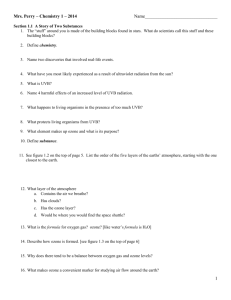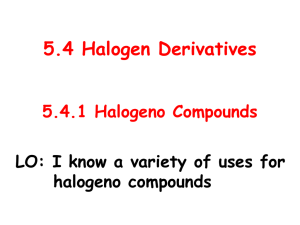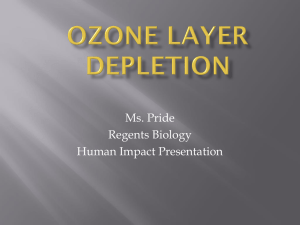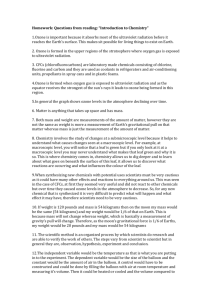Chemistry Worksheet: Ozone, CFCs, Matter, Scientific Method
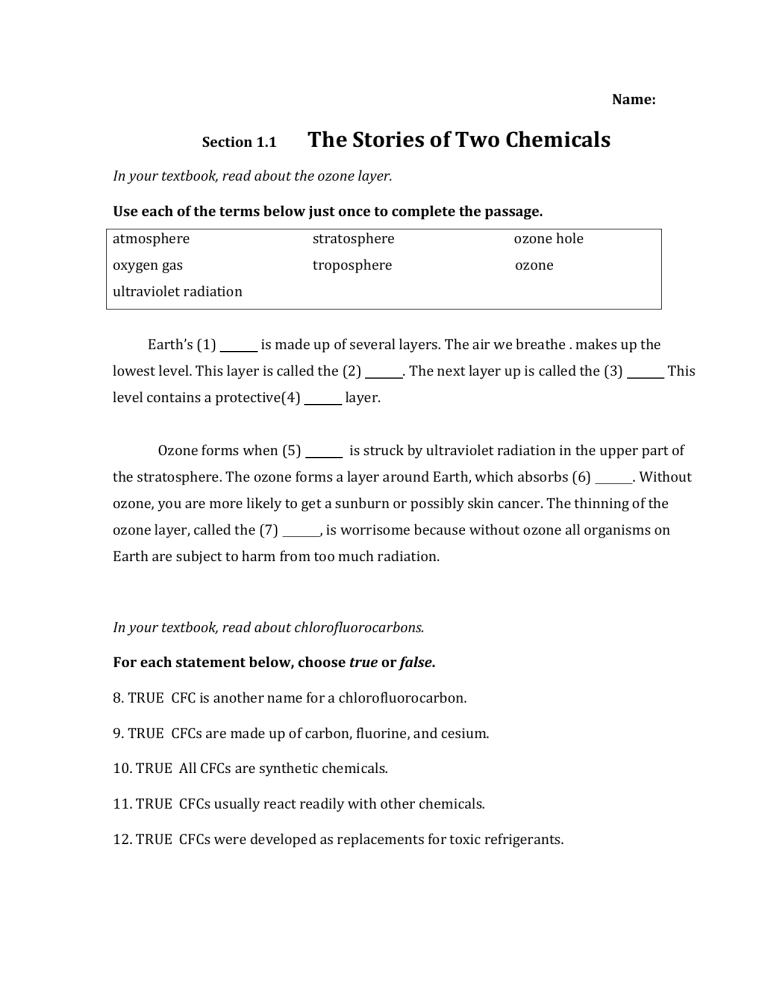
Section 1.1
The Stories of Two Chemicals
Name:
In your textbook, read about the ozone layer.
Use each of the terms below just once to complete the passage. atmosphere stratosphere ozone hole oxygen gas troposphere ozone ultraviolet radiation
Earth’s (1) is made up of several layers. The air we breathe . makes up the lowest level. This layer is called the (2) . The next layer up is called the (3) This level contains a protective(4) layer.
Ozone forms when (5) is struck by ultraviolet radiation in the upper part of the stratosphere. The ozone forms a layer around Earth, which absorbs (6) . Without ozone, you are more likely to get a sunburn or possibly skin cancer. The thinning of the ozone layer, called the (7) , is worrisome because without ozone all organisms on
Earth are subject to harm from too much radiation.
In your textbook, read about chlorofluorocarbons.
For each statement below, choose true or false.
8. TRUE CFC is another name for a chlorofluorocarbon.
9. TRUE CFCs are made up of carbon, fluorine, and cesium.
10. TRUE All CFCs are synthetic chemicals.
11. TRUE CFCs usually react readily with other chemicals.
12. TRUE CFCs were developed as replacements for toxic refrigerants.
Section 1.2
Chemistry and Matter
Type each term below under the correct heading. Use each term only once. air magnetic field car feeling heat human body radio wave flashlight textbook thought light radio
Made of Matter
1.
2.
3.
4.
5.
6.
Not Made of Matter
7.
8.
9.
10.
11.
12.
For each statement below, choose true or false.
14. TRUE The mass of an object can vary with the object’s location.
15. TRUE A mass measurement includes the effect of Earth’s gravitational pull on the object being measured.
16. TRUE Scientists measure the amount of matter in terms of mass.
17. TRUE Subtle differences in weight exist at different locations on Earth.
18. TRUE Your mass on the Moon would be smaller than your mass on Earth.
For each branch of chemistry in Column A, match the letter of the item in Column B that pertains to that branch.
Column A
26. A Organic chemistry
Column B a. reaction mechanisms
27. A Physical chemistry
28. A Biochemistry b. minerals c. plastics
29. A Analytical chemistry
30. A Inorganic chemistry d. metabolism e. quality control
Section 1.3
Scientific Methods
31. (1)
32. (2)
33. (3)
34. (4)
35. (5)
Match the term in column A to the definition in Column B.
Column A
36. A Refers to physical characteristics
37. A Refers to mass, volume, and temperature measurements
38. A A variable controlled by the experimenter
39. A The act of gathering information
40. A Changes in value based on the value of the controlled variable
Column B
A. Observation
B. Qualitative data
C. Quantitative data
D. Independent variable
E. Dependent variable
Section 1.4
Scientific Research
In your textbook, read about types of scientific investigations.
For each description below, determine if it is applied research or pure research.
41. Applied Research Is undertaken to solve a specific problem
42. Applied Research Seeks to gain knowledge for the sake of knowledge itself
43. Applied Research Is used to find CFC replacements
44. Applied Research Was conducted by Molina and Rowland
45. Applied Research Finding alternative fuel sources



